2017 AComparativeStudyofWordEmbeddin
- (Dhingra et al., 2017) ⇒ Bhuwan Dhingra, Hanxiao Liu, Ruslan Salakhutdinov, and William W. Cohen. (2017). “A Comparative Study of Word Embeddings for Reading Comprehension.” In: arXiv, abs/1703.00993.
Subject Headings: Word Embedding; Reading Comprehension Task; OOV Token.
Notes
Cited By
- Google Scholar: ~ 27 Citations.
Quotes
Abstract
The focus of past machine learning research for Reading Comprehension tasks has been primarily on the design of novel deep learning architectures. Here we show that seemingly minor choices made on (1) the use of pre-trained word embeddings, and (2) the representation of out-of-vocabulary tokens at test time, can turn out to have a larger impact than architectural choices on the final performance. We systematically explore several options for these choices, and provide recommendations to researchers working in this area.
1. Introduction
Systems that can read documents and answer questions about their content are a key language technology. The field, which has been termed Reading Comprehension (RC), has attracted a tremendous amount of interest in the last two years, primarily due to the introduction of large-scale annotated datasets, such as CNN (Hermann et al., 2015) and SQuAD (Rajpurkar et al., 2016).
Powerful statistical models, including deep learning models (also termed as readers), have been proposed for RC, most of which employ the following recipe: (1) Tokens in the document and question are represented using word vectors obtained from a lookup table (either initialized randomly, or from a pre-trained source such as GloVe (Pennington et al., 2014). (2) A sequence model such as LSTM (Hochreiter and Schmidhuber, 1997), augmented with an attention mechanism (Bahdanau et al., 2014), updates these vectors to produce contextual representations. (3) An output layer uses these contextual representations to locate the answer in the document. The focus so far in the literature has been on steps (2) and (3), and several novel architectures have been proposed (see Section 2.1).
In this work, we show that seemingly minor choices made in step (1), such as the use of pretrained word embeddings and the handling of outof-vocabulary tokens at test time, can lead to substantial differences in the final performance of the reader. These differences are usually much larger than the gains reported due to architectural improvements. As a concrete example, in Figure 1 we compare the performance of two RC models — Stanford Attentive Reader (AR) (Chen et al., 2016) and Gated Attention (GA) Reader (Dhingra et al., 2016) — on the Who-Did-What dataset (Onishi et al., 2016), initialized with word embeddings trained on different corpora. Clearly, comparison between architectures is meaningful only under a controlled initialization method.
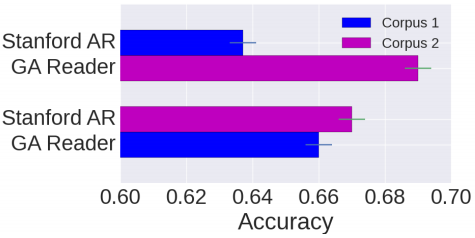
|
To justify our claims, we conduct a comprehensive set of experiments comparing the effect of utilizing embeddings pre-trained on several corpora. We experiment with RC datasets from different domains using different architectures, and obtain consistent results across all settings. Based on our findings, we recommend the use of certain pre-trained GloVe vectors for initialization. These consistently outperform other off-the-shelf embeddings such as word2vec[1](Mikolov et al., 2013), as well as those pre-trained on the target corpus itself and, perhaps surprisingly, those trained on a large corpus from the same domain as the target dataset.
Another important design choice is the handling of out-of-vocabulary (OOV) tokens at test time. A common approach (e.g. (Chen et al., 2016; Shen et al., 2016)) is to replace infrequent words during training with a special token UNK, and use this token to model the OOV words at the test phase. In reading comprehension, where the target answers are often rare words, we find that this approach leads to significantly worse performance in certain cases. A superior strategy is to assign each OOV token either a pre-trained, if available, or a random but unique vector at test time. We discuss and compare these two strategies, as well a mixed variant of the two, in Section 3.2.
2. Background
2.1 RC Datasets & Models
Many datasets aimed at measuring the performance of RC have been proposed (Nguyen et al., 2016; Trischler et al., 2016). For our purposes, we pick two of these benchmarks from different domains – Who-Did-What (WDW) (Onishi et al., 2016) constructed from news stories, and the Children's Book Test (CBT) (Hill et al., 2015) constructed from children's books. For CBT we only consider the questions where the answer is a named entity (CBT-NE). Several RC models based on deep learning have been proposed (Cui et al., 2016; Munkhdalai and Yu, 2016; Sordoni et al., 2016; Shen et al., 2016; Kobayashi et al., 2016; Henaff et al., 2016; Wang and Jiang, 2016; Wang et al., 2016; Seo et al., 2016; Xiong et al., 2016; Yu et al., 2016). For our experiments we pick two of these models: the simple, but competitive, Stanford AR, and the high-performing GA Reader.
Stanford AR
The Stanford AR consists of single-layer Bidirectional GRU encoders for both the document and the query, followed by a bilinear attention operator for computing a weighted average representation of the document. The original model, which was developed for the anonymized CNN/Daily Mail datasets, used an output lookup table $W_a$ to select the answer. However, without anonymization the number of answer candidates can become very large. Hence, we instead select the answer from the document representation itself, followed by an attention sum mechanism (Kadlec et al., 2016). This procedure is very similar to the one used in GA Reader, and is described in detail in Appendix A.
GA Reader
The GA Reader is a multi-hop architecture which updates the representation of document tokens through multiple bidirectional GRU layers (Cho et al., 2014). At the output of each intermediate layer, the token representations are re-weighted by taking their element-wise product with an attention-weighted representation of the query. The outputs of the final layer are further matched with the query representation with an inner product to produce a distribution over the candidate answers in the document, and multiple mentions are aggregated using attention sum. We use the publicly available code[2] with the default hyperparameter settings of (Dhingra et al., 2016), detailed in Appendix B.
2.2 Word Embedding Methods
The two most popular methods for inducing word embeddings from text corpora are GloVe (Pennington et al., 2014) and word2vec (Mikolov et al., 2013). These packages also provide off-the-shelf (OTS) embeddings trained on large corpora[3]. While the GloVe package provides embeddings with varying sizes (50-300), word2vec only provides embeddings of size 300. This is an important difference, which we discuss in detail later. We also train three additional embeddings, listed in Table 1, including those trained on the target datasets themselves. In summary, we test with two in-domain corpora for WDW: one large (OTS) and one small (WDW), and two in-domain corpora for CBT: one large (BT) and one small (CBT).
| Emb. | Corpus | Domain | Size | Vocab |
|---|---|---|---|---|
| OTS | Wiki + Gigaword/ | Wiki/ | 6B/ | 400K/ |
| GoogleNews | News | 100B | 3M | |
| WDW | Who-Did-What | News | 50M | 91K |
| BT | BookTest | Fiction | 8B | 1.2M |
| CBT | Children's BookTest | Fiction | 50M | 48K |
When training embeddings, we set hyperparameters to their default values in the provided packages (see Appendix B for details). This is by no means an optimal choice, in fact previous studies (Levy et al., 2015) have shown that hyperparameter choices may have a significant impact on downstream performance. However, training a single RC model can take anywhere from several hours to several days, and tuning hyperparameters for the embedding method on this downstream task is both infeasible and rarely done in practice. Instead, our objective is to provide guidelines to researchers using these methods out-of-the-box.
3. Experiments and Results
3.1 Comparison of Word Embeddings
We repeat each experiment twice with different random seeds and report the average test set accuracy across the two runs. Figure 2 shows a comparison of the RC performance for GA Reader and Stanford AR after initializing with various pretrained embeddings, and also after initializing randomly. We see consistent results across the two datasets and and the two models.
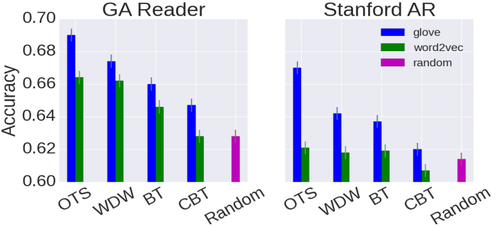
|
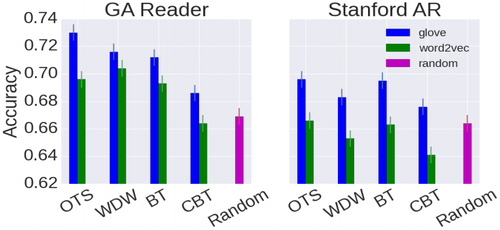
|
The first observation is that using embeddings trained on the right corpora can improve anywhere from 3-6% over random initialization. However, the corpus and method used for pre-training are important choices: for example word2vec embeddings trained on CBT perform worse than random. Also note that in every single case, GloVe embeddings outperform word2vec embeddings trained on the same corpora. It is difficult to claim that one method is better than the other, since previous studies (Levy et al., 2015) have shown that these methods are sensitive to hyperparameter tuning. However, if used out-of-the-box, GloVe seem]]s to be the preferred method for pre-training.
The single best performance is given by off-the-shelf GloVe embeddings ($d = 100$) in each case, which outperform off-the-shelf word2vec embeddings ($d = 300$). To understand if the difference comes from the differing dimension sizes, we plot the performance of GloVe embeddings as the dimension size is increased in Figure 3 (left). Performance drops as the embedding dimension size is increased (most likely due to over-fitting); however even at $d = 300$, GloVe embeddings outperform word2vec embeddings.
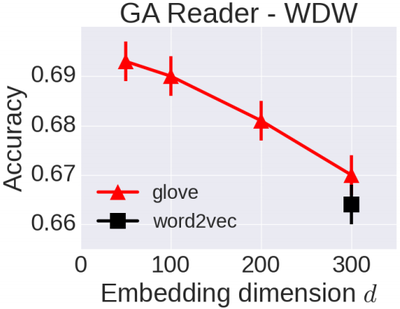
|
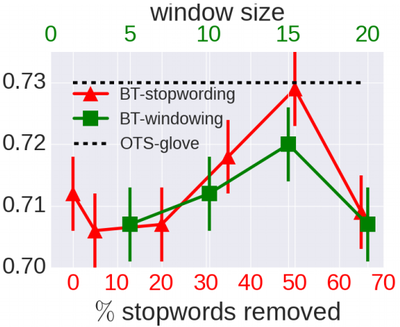
|
On both test datasets embeddings trained on formal domains, like news (OTS, WDW), perform at least as well as those trained on informal ones, like fiction (BT, CBT). This is surprising for CBTNE dataset which is itself constructed from the informal domain of children's books. For example, WDW (50M tokens) does significantly better than CBT-NE (50M tokens) in 3 out of the 4 cases, and also significantly better than the much larger BT (8B tokens) in one setting (and comparably in other settings). A key distinguishing feature between these two domains is the fraction of text composed of stopwords[4] – WDW consists of 54% stopwords while BT consists of 68% stopwords. Both GloVe and word2vec induce word vectors by minimizing the Euclidean distance between vectors of frequently co-occurring words. Co-occurrence with stopwords, however, provides little meaningful information about the semantics of a particular word, and hence corpora with a high percentage of these may not produce high-quality vectors. This effect may be mitigated during pretraining by either, (1) removing a fraction of stopwords from the corpus, (2) increasing the window size for counting co-occuring words. Figure 3 (right) shows the effect of both these methods on downstream RC performance. There is an improvement as the fraction of stopwords decreases or the window size increases, upto a certain limit. In fact, with proper tuning, BT embeddings give roughly the same performance as OTS GloVe, emphasizing the importance of hyperparameter tuning when training word vectors. There is also evidence that stopword removal can be beneficial when training word vectors, however this needs further verification on other downstream tasks.
3.2 Handling OOV tokens
In this section we study some common techniques for dealing with OOV tokens at test time. Based on the results from the previous section, we conduct this study using only the off-the-shelf GloVe pre-trained embeddings. Let the training, test and GloVe vocabularies be denoted by $V^T$, $V^E$ and $V^G$ respectively. Also define $V^T_n = \{t \in V^T: \# t \gt n\}$ where $\# t$ denotes the count of token $t$ in the training corpus. Before training a neural network for RC, the developer must first decide on the set of words $V$ which will be assigned word vectors. Any token outside $V$ is treated as an OOV token (denoted by UNK) and is assigned the same fixed vector.
By far the most common technique in NLP literature (e.g. (Chen et al., 2016; Shen et al., 2016)) for constructing this vocabulary is to decide on a minimum frequency threshold $n$ (typically 5 - 10) and set $V = V^T_n$. Out of these, vectors for those which also appear in $V^G$ are initialized to their GloVe embeddings, and the rest are randomly initialized. Remaining tokens in $V^T$ and those in $V^E − V^T$ are all assigned the UNK vector, which is itself updated during training. This method ignores the fact that many of the words assigned as UNK may have already trained embeddings available in $V^G$. Hence, here we propose another strategy of constructing the vocabulary as $V = V^T_n \cup V^G$. Then at test time, any new token would be assigned its GloVe vector if it exists, or the vector for UNK. A third approach, used in (Dhingra et al., 2016), is motivated by the fact that many of the RC models rely on computing fine-grained similarity between document and query tokens. Hence, instead of assigning all OOV tokens a common UNK vector, it might be better to assign them untrained but unique random vectors. This can be done by setting the vocabulary to $V = V^T_n \cup V^E \cup V^G$. Hence, at test time any new token will be assigned its GloVe vector if it exists, or a random vector. Note that for this approach access to $V^E$ at training time is not needed.
Figure 4 shows a comparison of all three approaches with varying n for the GA Reader on WDW and CBT-NE datasets. A gap of $3\%$ and $11\%$ between the best and worst setting for WDW and CBT-NE respectively clearly indicates the importance of using the correct setting. The commonly used method of setting $V = V^T_n$ is not a good choice for RC, and gets worse as $n$ is increased. It performs particularly poorly for the CBT-NE dataset, where $\sim 20%$ of the test set answers do not appear in the training set (compared to only $\sim 1.5%$ in WDW). The other two approaches perform comparably for WDW, but for CBT-NE assigning random vectors rather than UNK to OOV tokens gives better performance. This is also easily explained by looking at fraction of test set answers which do not occur in $V^T_0 \cup V^G$ – it is $\sim 10\%$ for CBT-NE, and $\gt 1\%$ for WDW. Since in general it is not possible to compute these fractions without access to the test set, we recommend setting $V = V^T_n \cup V^E \cup V^G$.
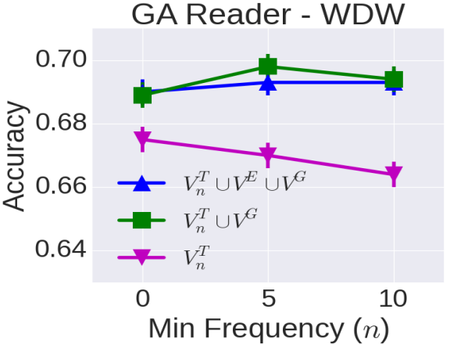
|
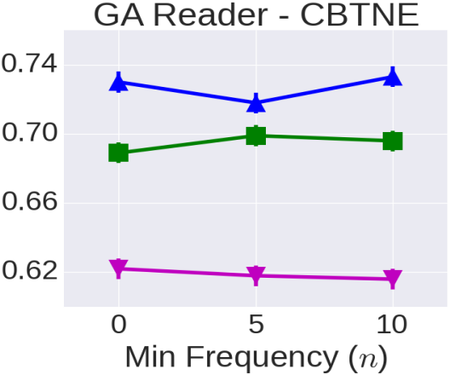
|
4. Conclusions
We have shown that the choice of pre-trained embeddings for initializing word vectors has a significant impact on the performance of neural models for reading comprehension. So does the method for handling OOV tokens at test time. We argue that different architectures can only be compared when these choices are controlled for. Based on our experiments, we recommend the use of off-the-shelf GloVe embeddings, and assigning pretrained GloVe vectors, if available, or random but unique vectors to OOV tokens at test time.
Acknowledgments
This work was funded by NSF under CCF1414030 and Google Research.
Appendixes
A. Answer Selection for Stanford AR
Using the notation from (Chen et al., 2016), let $\tilde{p}_1, \tilde{p}_2,\ldots , \tilde{p}_m$ be the contextual embeddings of the tokens in the document, and let o be the attention-weighted document representation, then we compute the probability that token $i$ answers the question as:
| $P\left(a=d_{i} \mid d, q\right)=s_{i}=\operatorname{softmax}\left(\tilde{p}_{i}^{T} o\right)$ | (1) |
The probability of a particular candidate $c \in C$ as being the answer is then computed by aggregating the probabilities of all document tokens which appear in $c$ and renormalizing over the candidates:
| $\operatorname{Pr}(c \mid d, q) \propto \sum_{i \in \mathbb{I}(c, d)} s_{i}$ | (2) |
where $\mathbb{I}(c, d)$ is the set of positions where a token in $c$ appears in the document $d$.
B. Hyperparameter Details
For the WDW dataset we use hidden state size $d = 128$ for the GRU and dropout with $p = 0.3$. For CBT-NE dataset we use $d = 128$ and dropout with $p = 0.4$. The Stanford AR has only $1$ layer as proposed in the original paper, while the GA Reader has 3 layers. For Stanford AR dropout is applied to the input of the layer, and for GA Reader it is applied in between layers. Embeddings sizes for the word vectors were set to $d_w = 100$ for all experiments, except those using off-the-shelf word2vec embeddings. To enable a fair comparison, we utilize the qe-comm feature for Stanford AR, which was used in the implementation of GA Reader. Since our purpose is to study the effect of word vectors, we do not use character embeddings in our experiments.
Footnotes
- ↑ https://code.google.com/archive/p/word2vec/
- ↑ https://github.com/bdhingra/ga-reader
- ↑ The word2vec package contains embeddings for both capitalized and lowercase words. We convert all words to lowercase, and if a word has both lowercase and uppercase embeddings we use the lowercase version.
- ↑ We use the list of stopwords available at http://research.microsoft.com/en-us/um/redmond/projects/mctest/data/stopwords.txt
References
2014
- (Pennington et al., 2014) ⇒ Jeffrey Pennington, Richard Socher, and Christopher D. Manning. (2014). “GloVe: Global Vectors for Word Representation.” In: Proceedings of the 2014 Conference on Empirical Methods in Natural Language Processing (EMNLP 2014).
2013
- (Mikolov et al., 2014) ⇒ Tomas Mikolov, Ilya Sutskever, Kai Chen, Greg S Corrado, and Jeff Dean. (2014). “Distributed Representations of Words and Phrases and their Compositionality.” In: Advances in Neural Information Processing Systems 26 (NIPS 2013).
BibTeX
@article{2017_AComparativeStudyofWordEmbeddin,
author = {Bhuwan Dhingra and
Hanxiao Liu and
Ruslan Salakhutdinov and
William W. Cohen},
title = {A Comparative Study of Word Embeddings for Reading Comprehension},
journal = {arXiv},
volume = {abs/1703.00993},
year = {2017},
url = {http://arxiv.org/abs/1703.00993},
eprint = {1703.00993},
}
| Author | volume | Date Value | title | type | journal | titleUrl | doi | note | year | |
|---|---|---|---|---|---|---|---|---|---|---|
| 2017 AComparativeStudyofWordEmbeddin | William W. Cohen Ruslan Salakhutdinov Hanxiao Liu Bhuwan Dhingra | A Comparative Study of Word Embeddings for Reading Comprehension | 2017 |